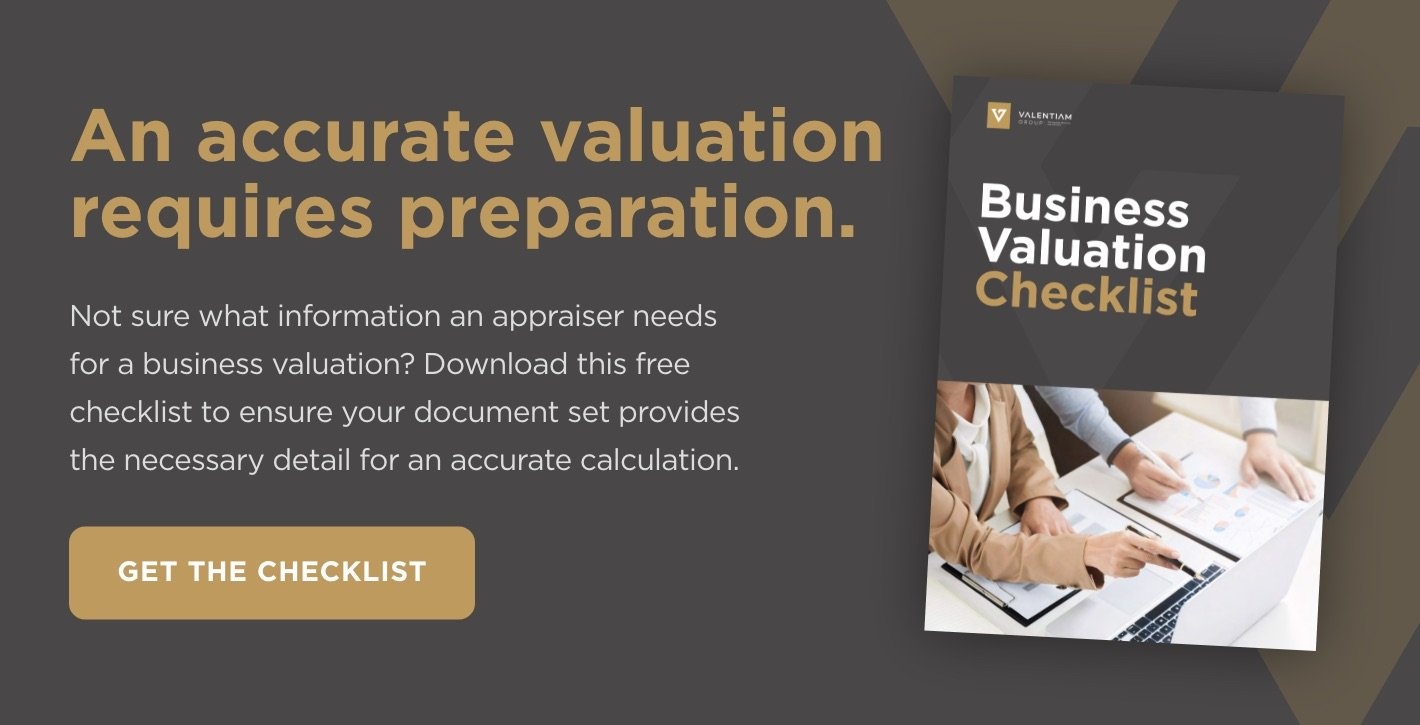Valuation Vs. Evaluation Vs. Appraisal—What's The Difference?
Posted by Valentiam Group on June 25, 2020

Discussions of business valuation often use the terms appraisal, valuation, and evaluation interchangeably, which raises the question: What is valuation vs. evaluation, and a business appraisal vs. a valuation? Is there a difference between all these terms? And if so, what do they all mean?
Opinions about the differences—or whether they actually have different meanings at all—are all over the map. If you do a Google search for evaluation vs. valuation, market appraisal vs. valuation, or any combination that reverses the terms (valuation vs. evaluation, valuation vs. appraisal, etc.), you will find a number of articles that attempt to draw distinctions. But in practice, the terms are used interchangeably and there is no legal difference in the definitions, nor any authoritative body that has assigned a definitive difference of meaning.
Instead, valuation companies and appraisers each seem to have their own ideas about the terms and how, or if, they differ. In this article, we’ll compare these terms and their meanings, and the process they are used to describe.
Valuation vs. Evaluation
At Valentiam, we consider business appraisal or valuation to be terms for describing the same thing. However, there is a difference between evaluation vs. valuation. Evaluation describes a more informal, ad hoc assessment; a valuation is a formal report that covers all aspects of value with supporting documentation. Others might define each slightly differently, or conclude there is no difference between the two. Here is the distinction we make: Evaluations of financial reports, assets, comparables, multiples, and more are the assessments we do to gather the information we need to prepare valuation estimates and reports.
That said, it’s not a distinction worth the investment of much time or mental effort. In practice, the terms appraisal, valuation, evaluation, and even assessment are generally used interchangeably in discussions about valuing businesses; the context in which they are used is more important. A valuation expert might say, “We did an evaluation of the company and determined its value is X,” when in fact he or she is describing the entire valuation process which resulted in a formal report.
What’s most important in a business valuation—whether it’s referred to as a valuation, an appraisal, or an evaluation—is the process for establishing the value of a business or business assets.
Business Appraisal Or Valuation Process
The process for establishing the value of a business follows a series of steps. These steps are covered in detail in a previous article and summarized here:
- Establish the purpose for the valuation.
- Determine the standard of value.
- Determine the basis of value.
- Determine the premise of value.
- Review the past performance of the business.
- Determine the future outlook for the business.
- Select and apply the appropriate valuation approach or approaches.
- Apply discounts.
- Formulate a conclusion of value.
As noted in this article, several steps in this process will determine the complexity of the valuation:
- The purpose for the valuation will often dictate the valuation approach or approaches to use, and has the biggest impact on the complexity involved in establishing value.
- The purpose for the valuation and the characteristics of the Subject Company will impact the effort required to gather and analyze data for the valuation.
- The type and number of valuation approaches required to establish a value will impact the effort required to both gather data and calculate value.
Once the purpose of the valuation is determined and the standard, basis, and premise of value are established, the appraiser collects the data needed to review the company’s performance compared to similar companies, make projections, and calculate value.
Data Required For Valuation
Valuation of a company requires—at a minimum—analysis of the Subject Company’s financial statements, legal agreements, ownership structure, and stock metrics (if the company is publicly traded) to evaluate assets and assess financial performance. It also requires data regarding similar companies’ assets and financial performance for comparison.
That is the bare minimum; in some cases—particularly valuations that require calculation of value using the cost approach—far more data is required, as detailed in the next section.
Download our free Business Valuation Checklist to learn about the information needed to calculate an accurate, comprehensive valuation of your business.
Appraisal Or Valuation Methods
The three valuation approaches used for establishing the value of businesses and business assets are the market, cost, and income methods. Each of these approaches has advantages and disadvantages, and situations to which they are most suited.
Market Valuation Methods
There are two different approaches to valuing a business using the market valuation method:
- Analysis of comparable publicly-traded companies’ value indicators: In this approach, the appraiser looks at the price/earnings ratio and other value metrics of similar companies’ stocks, calculates the averages, and applies the averages to the Subject Company. While this method is a relatively quick and easy way to estimate value, estimate is the key word—this method is very imprecise. That’s due to the fact that markets can under- or over-value companies, and the difference in multiples among similar companies may be due to specific factors unique to the individual companies.
- Analysis of comparable sales: As with real estate comparables, this method analyzes the recent sales prices of companies similar to the Subject Company. To account for differences between comparables and the Subject Company, adjustments are made. The drawbacks to this approach can include a lack of comparable transactions in the market, a lack of credible sources to support independent verification of value, and subjectivity in making value adjustments to the comparables and Subject Company.
The market valuation method provides an estimate of the market rate for similar businesses at a particular point in time, but for most cases will not provide a definitive fair value of the Subject Company. This approach, however, is sometimes used to establish value for mergers and acquisitions (M&A). The market approach is also a commonly used valuation method in finance.
The Cost Valuation Method
The principle of substitution is the basis of the cost approach to valuation. This concept holds that prudent investors will not pay more for an asset than they would pay for an alternate asset of equal utility. Like the market approach, there are two methods for applying the cost approach: reproduction cost and replacement cost. The replacement cost approach better aligns with the principle of substitution, since a prudent investor would not choose to replicate an existing property incorporating obsolete features. For this reason, reproduction cost is not often used in valuations using the cost approach.
In the cost valuation approach, the Subject Company is replicated from the ground up, using current market prices to calculate the cost of replacing all of the Subject Company’s assets. Typically the replacement cost is lower than the Subject Company’s book value, because it eliminates all obsolete or underutilized assets. This value is then adjusted for depreciation, which reduces the value further.
The cost approach is a solid capital valuation method, firmly grounded in current market costs, and provides a clear value for tangible assets. It can be used with the income approach to indirectly value intangible assets as well, by subtracting the value of tangible assets derived from the cost approach from the enterprise value established through the income approach. Its main limitation is that it requires a lot of reliable data; it also requires the calculation of the cost of materials, equipment, and labor needed to replicate the Subject Business. The research and analysis required to calculate value using the cost approach is very time-intensive.
The Income Valuation Method
The premise of the income approach is that an asset’s current full cash value is equal to the present value of future cash flows it will generate over its remaining economic life. (Tweet this!) Although the income approach is a classic approach to valuation, it requires an extensive amount of detail and analysis, and it has significant model risk due to its reliance on a number of assumptions.
There are several steps to applying this approach:
- Estimation (forecast) of annual cash flows an investor would expect from the Subject Company over a defined period of time
- Conversion of those cash flows to their present value equivalent, using a rate of return to account for risk and the time value of money
- Estimation of residual value at the end of the projection period
- Conversion of residual value to its present value equivalent
- Addition of the present value of estimated cash flows from the projection period to the residual value to calculate the Subject Company’s enterprise value
- Deducting working capital, intangible property, and other excluded assets of the enterprise value to determine value of the Subject Company’s tangible assets
The income approach is useful for calculating a fair and defensible enterprise value. However, in situations where tangible assets need to be valued separately—for example, to establish value for property tax purposes—the income approach does not allow separation by type of asset. This shortcoming can be addressed by combining the income approach with the cost approach, which allows the valuation of tangible assets and the indirect valuation of intangible assets.
A more critical limitation is the income approach’s reliance on assumptions about the forecast period, the cost of capital, and the terminal growth rate. Small changes in these assumptions can have a large material impact on the value derived. The future is uncertain, and projections made years into the future may not hold true. Due to these limitations, the income approach is most appropriate for businesses with stable and predictable cash flows.
Applying Discounts
After a value has been calculated using one or more of the valuation approaches outlined above, it must be adjusted by the following discounts, where applicable, which may impact the value of the Subject Company:
- Marketability discount: This discount considers the lack of ability to rapidly convert an ownership stake to cash.
- Key man discount: If the company is young or there is a lot of value associated with a particular individual, the impact of that person leaving could be substantial. Examples might include Apple and Steve Jobs, Tesla and Elon Musk, or Berkshire Hathaway and Warren Buffet. The value of each of these companies without the “key man” is likely to be less (and in the case of Apple, real-world experience illustrated the principle).
- Control discount: If a minority stake in a private company is sold, a value adjustment needs to be made to account for this lack of operational and financial control. This can also apply in a public company but will have a much smaller impact.
Once all applicable discounts have been applied, the appraiser can arrive at a final conclusion of value and compile the business valuation report.
Regardless of the terminology used—valuation vs. evaluation, market appraisal vs. valuation, or valuation vs. assessment—determining the value of a business or business assets is a complex process requiring the skills of experienced professionals. Business valuation experts have the experience and knowledge needed to calculate a fair and defensible value for your company.
Need help determining the value of your business?
At Valentiam, our valuation specialists are experienced in all valuation methods acceptable in accounting practice. We bring collective decades of expertise in valuation and transfer pricing to every project. Give us a call to see how we can help you with your business valuation and transfer pricing needs.
Topics: Business valuation
Related Posts
EBITDA Multiples By Industry: An Analysis
EBITDA multiples by industry indicate growth, profitability, and stability of profits in various sectors—and are a quick and easy way to estimate value.
Valuation Methods: A Guide
Different types of business valuation methods are suited to specific needs. Here are the three primary types of valuation techniques and when they should be used.


